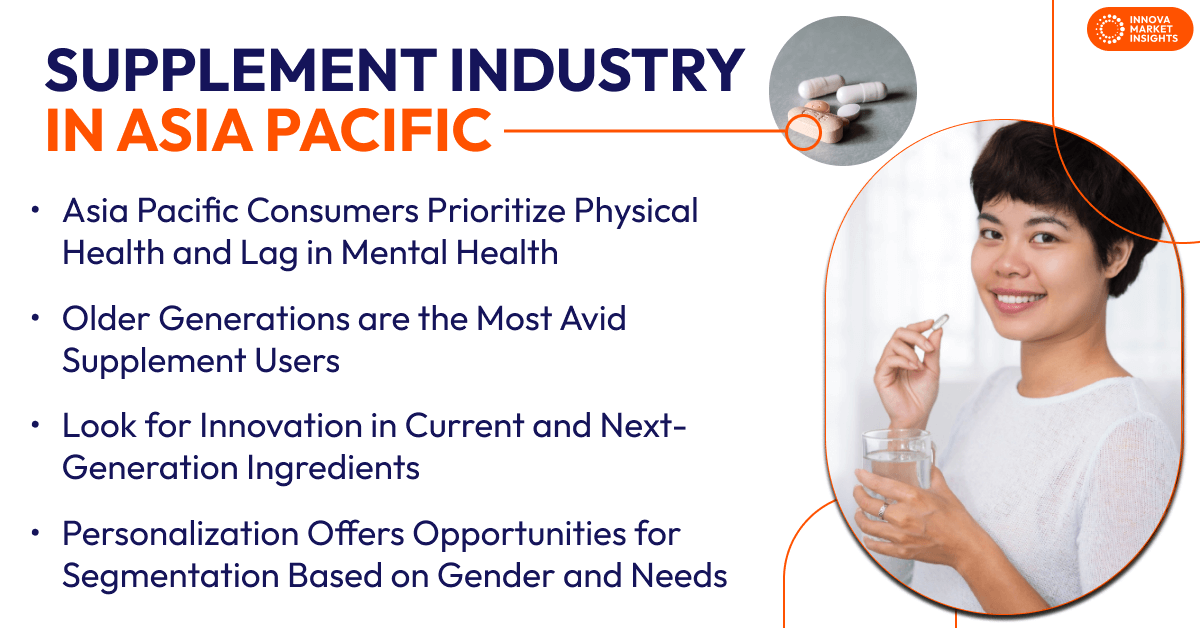August 22, 2025 – Many factors impact key trends in the Asia Pacific supplements marketplace. These can include large scale global forces, trends at the category and product level that are monitored by Innova Market Insights, consumer trends and drivers, dynamics among competitors in the market, major players and their strategies, and innovation in new product launches. It also is important to postulate on what’s next.
Data from the Asia Pacific region includes up to 18 countries – Bangladesh, China, Hong Kong, India, Indonesia, Japan, Malaysia, Myanmar, Nepal, Philippines, Singapore, South Korea, Sri Lanka, Taiwan, Thailand, Vietnam, Australia and New Zealand. Representative countries for consumer trends are China, India, and Indonesia.
Definitions of Supplements
The universal definition for supplements is products taken by mouth and meant to supplement diet and health. Supplements are not food or beverages. Supplements are available in many different formats, including tablets and pills, capsules, liquids, powders, gels, gummies, and chews. The various subcategories of supplements focus on specific health and nutrition benefits. Amino acid supplements include single amino acids or combinations of amino acids. Antioxidant supplements can contain one or more active ingredients, including polyphenols, lutein, zeaxanthin, resveratrol, and others.
In the supplement industry, aromatherapy supplements contain scented compounds from flowers, plants, fruit, or vegetables. Botanical and herbal supplements come from a broad range of plants with health benefits. Extracts may be derived from animal tissue, leaves, fruit, or other plants. Fiber supplements can contain soluble fiber, insoluble fiber, or both. Some supplements provide digestive and other enzymes. Essential fatty acid supplements contain fish oil, plant-derived oils, or both. Marine supplements are just from marine sources.
Concentrates can be derived from fruit or vegetables. Probiotic supplements contain lactic acid and other beneficial bacteria. Supplements may be positioned for specific benefits, for example, hair, skin, and nails, bones, heart, weight loss, or weight gain. Or they can be traditional vitamin and mineral supplements. Supplements can be targeted to age demographics, for example, children or seniors. Some supplements are positioned for women, or for men.

Consumer Trends Show Asian Self-Sufficiency
In consumer trends research conducted by Innova Market Insights, high percentages of Asian consumers describe themselves as self-sufficient or becoming more self-sufficient about their personal health care. Consumers in the Asia Pacific region are drawn to convenience and personalization, and supplements can provide both benefits. A proportion of Asian consumers turn to supplements for targeted nutrition, more for physical health benefits than for mental health benefits. Mental health supplements represent an Asia Pacific opportunity area for manufacturers. Looking at generations, Asian Boomers are the most avid supplement users, but younger generations are more captivated by newer formats such as chews and drinks.
Regional Trends Offer Innovation Opportunities
The Asia Pacific region accounts for a sizable proportion of supplement industry sales by value but it lags in innovative launches. New product launches monitored by Innova resemble patterns for Western countries while Asian countries are diverse. The Chinese marketplace tends to have a general health focus and India features botanicals. Knowledge of the local marketplace is essential. In addition to local differences, supplements in the Asia Pacific region are targeting individual health needs for skin, brain, sleep, energy, and women. Companies also are introducing innovative specialty ingredients.
Opportunities to Meet Various Consumer Needs
The physical needs of consumers are prominent. Asian participants in consumer trends research have highest levels of concern regarding sleep and weight management, followed by bone and joint health, energy, eye health, gut health, immunity, and skin health. The use of supplements for mental health is much less frequent. But some benefits are growing, for example, claims for helping with insomnia.
Supplement industry trends show younger consumers use supplements less frequently than older ones, but on-trend benefits and new formats could attract them.
Supplement Ingredients Can Add Value
Innovation in supplement ingredients adds value in the supplement industry, as manufacturers look for ingredients that are more advanced. These can include the emerging ingredient subcategories of collagen and amino acids, along with next-generation botanical ingredients. Several other ingredients are emerging and could contribute to supplement innovation in APAC countries and for APAC consumers.
Personalized Supplements to Meet Personalized Needs
Segmentation of the marketplace allows for personalization of supplements. Areas for potential innovation include supplements for life stages, gender, and lifestyles. Supplements also can be personalized to meet trending health needs such as skin health and brain health. GLP-1 drugs present another opportunity to personalize supplementation. Growing use in North America has led to supplement industry trends focused on GLP-1 users. GLP-1 trends are just starting in APAC countries and may open the door for further supplement industry opportunities.”
Younger consumers have distinct needs for supplements today and into the future. This presents an opportunity for brands in the supplement industry to modernize their supplement products and packaging. Examples include indulgent supplement experiences with innovative flavors in new formats that are popular with younger consumers.
It will be important to tailor innovation to the country and consumers. Active ingredients can differ among countries, for example, botanicals in India, technologically advanced ingredients in South Korea and Japan, and new ingredients to meet personalized health needs in Japan. That is why consumers in each Asia Pacific country will help drive supplement innovation that is specific to the country.
This article is based on Innova’s Supplements in Asia Pacific report. This report is available to purchase or with an Innova Reports subscription. Reach out to find out more
